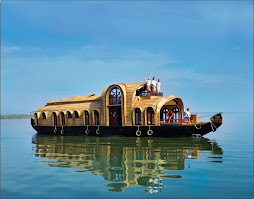The legacy of Portuguese, Dutch and the British is seen @ Fort St. Angelo. It was built by Sir Francisco De Almeida in 1505, ( almost 500 years old ) on the shores of Arabian sea, for guarding the town against attack from the sea by pirates and subsequently foreign enemies. The fort signifies the first sign of colonization attempt by Portuguese who had essentially landed in India for trading of spices on the Kerala coast. It was built by Almeida with the permission the prevailing king of kolathiri Raja.
The fort has been constructed using the laterite stones which are available in plenty in the region. These stone are amenable for strong construction due to its easy chiseling and blends very well with the limestone. Currently ASI is upgrading the Fort to its original grandeur using the same materials and conserving this magnifcient heritage of 4 different eras. Some of the fallen edifices are rebuilt and numbered according to the sequence. The evidence of the same can be found is some portions of the fort, in particular when one climbs toward lighthouse from the inner ramparts of the fort.
The Dutch captured the fort from the Portuguese in 1663 and made some alteration to the fort. The epigraphical evidence is noticed on the tablet form of inscriptions on the walls of the fort. An ancient lighthouse was built to warn the ships of the shoreline which needed to sailed with caution due to prevalent rocky mass in the midst. This ancient lighthouse was later discontinued with the construction of a modern lighthouse by the british. The dutch sold the fort to Arrakkal Kings in 1772 before vacating the Indian shores due to trouble in their own country. The British captured the fort from the Arrakkal kings in 1790 and established it as the prime base shifting from Tellicherry fort because of the vantage location. They occupied the Fort and monitored the port of Mappila, which was essentially fishing and trading harbor after Kozhikode ( Calicut ). In 1947 when the british vacated India it was taken over by the ASI under the Indian Navy which has its presence in the huge complex. Maybe some of the old structures have been occupied from the British regime. The entire premise is very clean and well maintained by ASI and it is a wonder ful historical heritage and full of legacy of ancient strategies followed. The booming cannons are deployed all over the Fort at Vantage points.
One can find lot of videographers willing to shoot pictures of the family in a professional manner at a price. Some of them ape song and dance sequence in the locales. The fort contains the Barracks of soldiers and stables for the horses too. An armoury storing the gunpowder does not seem out of place considering the no of cannons.
LIGHTHOUSE
An Iron pillar like structure situated on the upper strata of the Fort ramparts was used as a Lighthouse to warn the ships sailing towards the the coast the dangers of the rocky coastline. The coastline in the entire belt is littered with such rocky formations which can damage and sink a ship into the Arabian seas. The Portugues used to light the same using candles and reflect the light vide a magnifying mirror, to warn the ships of the imminent dangers.
CANNONS
There are number of cannons which are preserved in it s pristine state, which gives us the real feel of the times. It transports the visitors that entire Fortress is ever ready for a battle. Very few forts in India have the weaponary displayed in their premises. Most of them are either shifted to muesuems or parks.
BARRACKS
A typical barrack of the Dutch era is seen in the fort premises, wherein the horses and soldiers lived side by side, guarding the entire fortress against the enemy attacks. The British may have used this place for their drills and flag hoisting ceremonies in all probability.
A beautiful painting of this elegant fortress and the fishing bay is displayed @ Rijks Museum in Amsterdam, Holland. The beheaded skull of Kunjalli Marakkar was exhibited @ the Fort premises by the dutch after his brutal assignation. There is museum of some of the exhibits which was closed at the time of my visit due to holiday I presume. May be I was so enamoured by the beauty of this fortress, I let go the museum.
One of the main high points of travel is in the form of Mappila cusine which is available in the restaurants @ kannur. The preparation in form of non veg delicacies with various spice mixture seems to be alluring. I just forgot to buy some authentic spices maybe next time around I will be able to purchase the same for domestic consumption.
Timings : Fort visiting time is 8.30 to 6.00 pm. The fort is guarded by tourism police and one of their constable Satyam has published a historical treatise on St Angelo fort. A video fee of Rs 25 is levied otherwise there is no enterance fee to the Fort.
Location : This fort is located approximately 3 kms from the Kannur Railway station, and autos generally charge double the meter ranging from Rs 25 to 40. The actual meter is only 13.60 exactly. Enroute one finds a small park maintained by the army which is full of antique weaponry used during the world war times. There is Mappilla Bay situation right opposite to the St Angelo fort and Arrakal museum located in parallel direction. Kannur has many other tourist attractions such as Payambalam Beach, Meenkunnu Beach, Snake park, Science Park, Folklore academy, Vallapatanam,Dharmadam Isle, Kunnimangalam, etc.
Thursday, November 12, 2009
Subscribe to:
Post Comments (Atom)









No comments:
Post a Comment